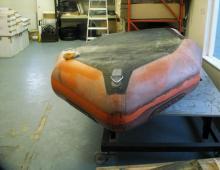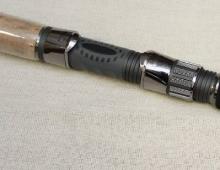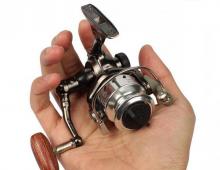Catching rotan in winter: on a mormyshka with a nozzle
Catching rotan in winter is a simple matter, but with its own nuances. In order to verify this, we go to one of our local reservoirs. In it, rotan has replaced other ichthyofauna and is found in the vast majority.
Lake Boyovskoye was chosen as the place where we will catch rotan today. It is located near Sysert - about a hundred miles from Yekaterinburg. Medium in size, not very deep - with swampy reed banks, quagmire, dark peaty water and a muddy bottom. Overgrown with algae. Ideal conditions for rotan. For the rest of the fish, the reservoir is potentially deadly, but for our object of fishing it is by no means. By the way, this is one of those factors that allow rotan to occupy a dominant position in a reservoir in a relatively short time.

Photo 2. From the satellite it is clearly visible how swampy the reservoir is.

Photo 3. View of the lake from the hard shore.
Tackle and bait used
Rotan belongs to those fish that are not particularly difficult to catch - if it is in a pond, it will peck at any winter gear, from a simple mormyshka to a vertical spinner. But it works most effectively nodding mormuscular tackle with a natural nozzle - this is confirmed by practice and statistics. Here we will take it for fishing.
The lion's share of water bodies in which rotan lives are swampy, and therefore - with limited conditions of perception. The water in them is saturated with organic matter, and therefore it does not transmit light well and even to some extent prevents the normal spread of odors. In order to survive in such conditions, in the course of evolution, rotan ideally developed its senses: sight, smell and lateral line. He relies heavily on them when hunting.
That is why a jig with a nozzle is the most effective bait, because it acts on the rotan as an irritant in all three directions.
Tackle device
We need a strong fishing rod with a more or less stiff whip, and a strong fishing line with a thickness of 0.16 mm. In any rotan pond, there is always a chance to meet a large fish weighing a kilo or more - this is what such a fishing line is needed for.

Photo 4
The bite of the rotan is usually sharp, confident. A piece of rubber or silicone nipple is suitable as a signaling device. On our tackle there is a combined guard made of thin plastic (from the outer part of the SIM card), cambric and a piece of nipple. He holds heavy bait well and, for all that, has increased sensitivity. Attached to the whip "crocodile".

Photo 5. Combined nod made of plastic, cambric and nipple. Mormyshka hangs above the bottom.
As a bait, a large soldered mormyshka with a hook of the fifth number is used. Its shape resembles a balalaika. Why is it large?

Photo 6. A variant of large jig used in catching rotan.
The rotan has a huge mouth, and the head does take up a third of its length. Thanks to this physique, he is theoretically able to cope with prey, almost the size of himself. Of course, such “fights” are rare, however, our gluttonous predator has long been noticed to have a predilection for larger “game”. That is - the use of large baits is highly justified and in demand.
The shape of the mormyshka is hardly of particular importance, in contrast to its color, which should contrast with the environment in order to attract fish from a long distance. And now, perhaps, it's time to mention everything that is put on the hook.
Nozzles for rotan
I am sure that many fishermen who know a lot about winter fishing, to the question “ what does rotan peck at in winter?", they will answer -" for all! And they will be right, because rotan is distinguished by its amazing omnivorousness. The list of baits used for catching it is quite wide - this includes both animals and plants. I don’t see much point in listing all of them (because you can put anything on the hook - it will bite!), But those that are most popular in jig fishing for this fish are worth noting.
- A piece of fish (including rotan) meat.
- Meat products and offal: chicken fillet, beef meat, liver (chicken and beef), lung, other liver, lard, etc. There are also cases of catching rotan on pieces of sausages.
- chicken skin.
I singled out the last point for a reason, because it is the answer to the question
What is the best way to catch rotan in winter?

Photo 7. A piece of chicken skin planted on a mormyshka hook. One of the best nozzles for catching rotan in winter.
Compared to other baits, chicken skin has a number of advantages:
- The first one is original scent, which is very to the liking of the rotan. There is no doubt that he likes it, it is clearly seen in the difference in the number of bites on the skin and other attachments.
- The second useful quality of chicken skin is ease. In the water, it emerges, due to which it acquires a horizontal position on the mormyshka hook. From the side, this design resembles a fish.
- The third quality is softness. In the water, the skin gets wet and thanks to this it sways from the slightest movement or wave, completely imitating a living creature - like a fry or a leech.
- chicken skin has light color and stands out well against the surrounding marsh background.
- In addition, she strong enough and withstands all bites.
- In some places of the chicken carcass (for example, on the lower back), on the underside of the skin there is a thin layer of fat. This can be called another useful quality of this nozzle, because the fat has its own smell and also attracts rotan.
Of course, you can successfully fish for lard, liver and other baits, but I strongly recommend taking at least small piece of chicken skin. It often happens that it is she who provides the best result in catching rotan in winter.
Cut the skin should not be anyhow, but an elongated triangle. The easiest way to do this is with scissors.
The piece is folded into a tube, and at the widest place is mounted on a hook. As a result, something is obtained that vaguely resembles a fry (see the previous photo).
A small piece of chicken skin was enough for one of my acquaintances, a fisherman, for several fishing trips. After the first of them - winding the fishing rods - he left a shred on the hook. It dried up safely and did not deteriorate. On the next fishing trip, the catcher launched a mormyshka with a dried skin into the hole - it quickly got wet and restored its qualities. Having caught, the fisherman removed the equipment from the water, but again did not remove the nozzle. She dried up again and was ready for the next fishing, on which everything was repeated.
However, I would not advise doing this, because over time the skin loses its taste and smell. Of course, they can be compensated by playing the bait, but still, in order to increase the efficiency of fishing, I strongly recommend changing the nozzle at least once every 2-3 hours (some fishermen even suggest changing the chicken skin on the hook every half hour).
Tactics of catching rotan in winter

Rotana in winter can be caught throughout the reservoir, but do not forget that he, like pike, hunts from ambush. Therefore, all those places where he has where to hide - he will prefer the rest.
Fishing places
On the lake where we “sharpened our skis” this time, it is mainly caught in the coastal zone: near the edge of thickets and clear water, in small bays that protrude into marshy shores, above underwater algae plantations, near quays. It is especially interesting to fish near the reeds. People do not climb into the middle, and not only because it freezes later than the edges, but also because rotan comes across small there.

Photo 9. People prefer to catch rotan near the shore.
Having decided on the place of fishing (near the reeds) - we drill several holes at a distance of 5 meters from each other. It is better not to be lazy with this matter, the larger the fishing area, the more fish there will be, in addition to this, the chance to detect a cluster of large individuals increases. In general, rotan does not really like to move around. He is not afraid of the noise of the ice drill, therefore - you can not be shy about drilling more holes.
A few lines about food
Should I use groundbait in catching rotan in winter? The question is moot. Some fishermen claim that if you throw a good handful of lean minced meat into the hole, this has a positive effect on the final result. Perhaps this is true, but only for the case when the fisherman sits on one hole. When it is supposed to actively run around several - it makes no sense to use bait. For example, I never feed rotan.
About the game with bait and the method of catching
Catching one hole is best done from the bottom, gradually raising the bait to the "ceiling", because rotan is often dispersed throughout the entire water column.
As for a specific game, the following trick works quite well: we put the bait on the bottom, knock it on it, then lift it up a bit and wait. It makes sense to wait about 30 seconds or even a minute. Then you should raise the bait and play with it for a short time: it is easy to vibrate - like a no-bait, pull like a mini-lure. After that, be sure to let her stop and pause again. Rotan can peck "on the game", but it often happens that he stands - he watches how the bait sways. Only when she freezes does he swim closer and grab her. I believe that such behavior is explained by the reluctance of winter rotan to chase actively moving prey and waste energy on it.
Usually, if the fish is under the hole, it starts to peck almost immediately. And so - until all the rotans located near the fishing point are caught. Therefore, if the bite stops, the hole should be changed.

Photo 10. Several rotans can be pulled out from one hole, but if their biting has stopped, the fishing place should be changed.
Whether the left hole “works” again after a while is an interesting question, it all depends on the activity of the fish.
Influence of weather conditions on the biting of rotan
Rotan by its nature is an unpretentious creature, however, its general activity, like that of other fish, depends on atmospheric phenomena. Changes in the weather (like a sudden cyclone) can make it lethargic, which will noticeably affect the bite. If the weather has “persisted” - rotan pecks most actively and can even make some migrations across the reservoir.
In lakes with brown peaty water, the bite of rotan can also be affected by general illumination. We have repeatedly noticed the following: if it is partly cloudy outside, then in cloudy moments the bite seems to subside, but as soon as the sun comes out, the bite intensifies. This is most likely due to reduced visibility under the ice - with high illumination, the rotan sees the bait in dark water better than with medium and low.
In such waters (especially in cloudy weather) it is best to use bright, shiny baits, or even phosphorescent ones.
The most active biting of rotan is observed on clear days with light frost. It is somewhat worse caught in windless cloudy weather. On rainy windy days, his bite is the worst.
In catching rotan in winter, there is another nuance that is directly related to the weather and local conditions. In frosty winters, large individuals of this fish reduce their activity - for them a kind of wilderness. Therefore, in the middle of the season, only small things peck, while large and medium rotans are caught only on the first and last ice. And if the reservoir is frozen or completely freezes to the bottom, there is nothing to do on it in the dead of winter.
Results of fishing
This time, the weather was not entirely lucky: a strong wind was blowing, and something unimaginable was clearly happening in the sky: either clouds were running up, or the sun was peeking out again. Rotan pecked inactively - I had to tease him with a game for a long time before he attacked the bait - and then on long pauses. The bites were noticeable, but somewhat sluggish. Our neighbors in the reservoir observed the same thing. Those who sat in one place and were too lazy to drill holes and run along them were especially unlucky with the catch.
Nevertheless, we managed to catch quite a decent amount of fish for this rainy day, among which there were quite good specimens. But to get this result, you had to work hard.




